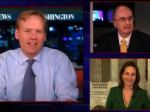Combing through news transcripts for bias indicators provides you with either unique insights or temporary insanity. Despite my questionable mental state, I’ve uncovered some subtler tricks-of-the-news-trade that I’d like to share with my readers.
Value Judgments: By definition, a value judgment is an assessment that reveals more about the values of the person making the assessment than about the reality of what is assessed. Value judgments can be either direct or projected.
Direct value judgments are often preceded with “I,” either explicitly or as understood. Examples are: “I don’t believe that …,” “that won’t work …” Projected value judgments are less obvious, but are used extensively by certain commentators and politicians. Speakers, often wrapping themselves in the flag or as the spokesperson for some popular group, stealthily project their personal opinions with statements like, “Americans won’t support…,”or “People are not going to …” It doesn’t jump out at you, but the speaker is putting their view in someone else’s mouth.
Loaded Questions and Leading Questions: A program anchor is in a position of power to determining how the news is presented while viewers sit passively, accepting that the commentator is objectively informing and moderating discussions based on years of conditioning. In the modern era of news programming that is often not the case. Dialogs are rife with loaded and leading questions.
The popular definition of a loaded question is one which contains as controversial assumption but, for the purposes of semantically evaluating bias, my definition is that it is one that contains indisputable evidence of bias. It gives a strong indication of how an anchor wants his/her respondent to answer. Guidelines for recognizing loaded questions include:
- Embedded value-judgments by the questioner: “Don’t you think that sounds <odd/wrong/funny/strange>”?
- Multiple questions within the same statement: “Who would support…?”, “What is the thinking….?”, “Where did they get…?”, “When …?”, “Why …?”
Leading questions are usually more subtle, and don’t have the clear indicators of loaded questions. Still, a savvy viewer can generally pick them out instinctively, particularly when considered together with succeeding responses. For the most part, news programs conform to the cardinal rule of litigation: Don’t ask a question if you don’t know how it will be answered. In the information age, commentators are rarely uninformed about the positions of their guests. In fact, most of them are regulars.
Once you are aware of these rhetorical devices, you’ll be surprised how often you will notice them while watching, “The News.”

